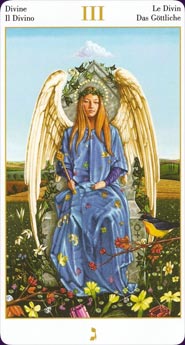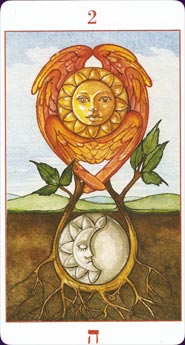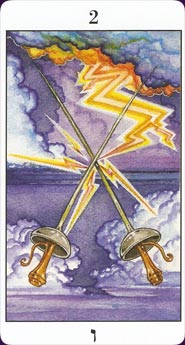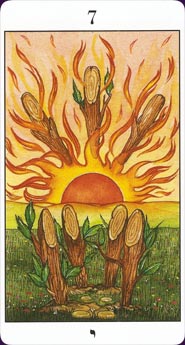Contemplative Tarot Deck Review
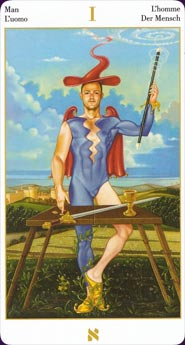
Creators: Adriano Buldrini
Published: 2008
The Contemplative Tarot is a thoughtful deck influenced by the works of philosopher P.D. Ouspensky. It has Pagan-inspired, lifelike, three- dimensional major arcana cards, while the minor arcana owe their basis to the el Gran Tarot Esoterico and are in a flatter, less-detailed artistic style.
Retailers
See Price at Amazon.comSee Price at Amazon.ca
Contemplative Tarot Review by Lillie
Its name would suggest The Contemplative Tarot is not intended for divination or fortune telling, instead it is made to aid in meditation and the quiet contemplation needed for the inner journey to self realisation. Indeed, it would be difficult to see how this deck could be used for the usual process of divination; the startling backs in five symbolically significant designs and six different colours would make it difficult to lay out the cards without some knowledge of their identity. Undoubtedly this is deliberate and is designed to remind the user of this decks stated purpose, meditation and contemplation.
The booklet of instructions provided with this deck also make its purpose clear and give more than enough information to allow the seeker of self knowledge to begin their inner journey. A brief introduction explaining some of the symbology used is followed by a short guide on how to begin meditating with these cards, an explanation that while brief is also precise and easy to follow. Lastly the booklet goes through all 78 cards suggesting questions that may be asked of each image and giving ideas and suggestions to aid meditation.
The images that grace the faces of these cards is lush, detailed and colourful and although there is a significant difference between the art styles of the major and minor arcana both are equally lovely in their own way. The pictures on the major arcana follow, on the whole, the Rider Waite standard and their iconography will therefore be familiar to most readers. The uncluttered white borders do not contain titles, only the number of the arcane, a Hebrew letter using the system of Levi rather than the Golden Dawn, and a simple designation that groups the cards into three groups of seven relating each one either to the individual, the world of matter or to the divine, while the XXI arcana is designated separately as a synthesis of the three groups. The simplicity of the borders focuses attention upon the rich colours and detail of the art allowing the seeker to concentrate their mind up on the images and symbols in order to find the answers they seek.
The minor arcana do not follow the figurative tradition of the Rider Waite deck, instead the relevant number of the suit signifier is shown woven into a symbolic picture or landscape reminiscent of the Vaschetta deck, Crowley’s Thoth or the geometric and symbolic simplicity of the decks of the Spanish school such as the Balbi. The suits are clearly tied to the elemental system where Wands are fire, Chalices represent water, Swords signify air and Pentacles are earth. These attributions are followed through in the art work, Chalices featuring an abundance of water; Swords are set against airy skies and so on. The suits are also assigned to the letters of the Tetragrammaton using the same system as the Golden Dawn where Yod, He, Vau, He are Wands, Chalices, Swords and Pentacles respectively. Once again the borders are kept very simple, showing only the Hebrew letter of the suit and the number allowing little distraction from the image itself. The lack of human figures on the minor cards mean that the seekers mind will not be constrained as they would on a differently designed deck by the presumed intention and personalities of the characters on the cards; but instead is allowed to freely explore the symbols in order to achieve wisdom.
The courts follow the traditional ranks of Knave, Knight, Queen and King, each card showing a distinct individual clearly displaying their suit symbol. The borders match those of the 40 minors, showing only the Hebrew letter and a simple symbol designating rank similar to those used for chess pieces. The distinct individuality of the characters portrayed on these cards, the difference in costume and apparent time period seem designed to make it easy for the seeker to differentiate between them during meditation, to draw from them the answers they are designed to give.
Overall this is a fascinating and unusual deck produced to the high quality one would expect from Lo Scarabeo. Its stated purpose as a tool for meditation and self exploration and not as a divinatory device, and the clear, uncompromising way this purpose has been followed through in the execution of this deck set it firmly in the forefront of the modern conception that seeks to make tarot a tool for guidance through the inner, spiritual journey rather than the mundane province of fortune tellers.
Contemplative Tarot Review by Bonnie Cehovet
The “Contemplative Tarot” is exactly that – a deck for contemplation and personal growth, rather than a deck for divinatory use (much the same as decks such as the “Square and Compass Tarot”, which is based on Free Mason imagery and symbols). From my personal point of view, this is a “serious” deck – and I love serious decks!
Based on the work of Russian philosopher P. D. Ouspensky, this deck is ripe with esoteric symbolism, and, wisely, comes with the stated purpose of encouraging each individual to “undertake an inner voyage to discover the evolution of your own Self through meditation and contemplation.”
Ouspensky associates each card of the Major Arcana to a setting of spiritual reference: seven cards refer to Man (and so to the individual); the second set of seven cards refer to The Universe, representing man’s (necessary) confrontation with the universal laws of Matter; the final group of seven cards refers to The Divine, that sphere related to transcendent reality. Together, these three spheres (human, universal, and divine) are joined by the XXI card, entitled “All”. (Note: Reading this part of t he LWB (Little White Book) answered a burning question for me – I am one of those who dives into the cards, “then” reads the LWB. Well, instead of titles for the Major Arcana cards, the spiritual reference (Man, Universe, Divine, The Whole) is noted. My question, of course, was: What is THIS all about!)
From the LWB:
“Man: The Fool, The Magician, The Lovers, The Chariot, The Hermit, The Hanged Man, The Devil
Universe: The Wheel of Fortune, Death, The Tower, The Star, The Moon, The Sun, Judgment
Divine: The High Priestess, The Empress, The Emperor, The Hierophant, Justice, Strength, Temperance
The Whole (All)”
The Hebrew letter associated with each of the Major Arcana cards is placed as a glyph at the bottom of each card. The sole exception would be XIII (Death), which has no Hebrew letter association. Death in the earlier decks was often not named, making it what the author of the text, Giovanni Pelosini, refers to as a “mute” expression of the Arcana.
The Minor Arcana suits are each associated with a letter of the Tetragrammaton: Wands – Yod, Chalices – He, Swords – Vau, Pentacles – He.
A rather interesting note about this deck has to do with the backs of the cards – there are six different colors and and five different designs used: the Fool carries the same design as the rest of the Major Arcana, only it is done in black, white, and gold. The backs of the other twenty-one cards are done in gold and white, with black line detail. The twenty-one Hebrew letters flow down both sides of the card and across the bottom. In the middle of the card we see the image of an angel, and across the top of the card we see the alchemical glyphs for Sulphur, Salt, and Mercury.
The color used for the back of the suit of Wands is red, with the symbols shown being the Lion of the Evangelist Mark, the alchemical Iron, and Elf, a sprig of summer grain, as well as glyphs for the Fire signs of the Zodiac, and the symbol for this element (a Wand).
The color used for the back of the suit of Chalices is green, with the symbols shown being the Archangel Matthew, the alchemical symbol for copper, a fairy, winter snow, glyphs for the Water signs of the Zodiac, and the symbol for this element (a Cup).
The color used for the suit of Swords is blue, with the symbols shown being the Eagle of Giovanni, the Swamp, a Sylph, an autumn leaf, glyphs for the Air signs of the Zodiac, and the symbol for this element (a Sword).
The color used for the back of the suit of Pentacles is yellow, with the symbols shown being the Bull of Luke, Lead, a Gnome, a spring flower, glyphs for the Earth signs of the Zodiac, and the symbol for this element (a Pentacle).
The LWB includes background on the cards, an explanation of the symbols on the cards, and a very gentle method for concentrating on the cards for meditative purposes. Each Major Arcana card is presented (text only) with a short paragraph on the card, followed by question to ask yourself. From the LWB:
“IX The Hermit (Theth) is nine, the number of truth and certainty, the end of one cycle and the beginning of another. The man wrapped in a grey cape bears a lantern and steps cautiously among slithering snakes who silently invite us to ask: “What do silence, solitude, and prudence mean to me? How can I attain patience?”
Each Minor Arcana card is presented (text only) with actions that the individual can take to bring the energy of the card into their life, along with questions to be meditated on. From the LWB:
“Ace of Pentacles: Identify my strongest talent and create something enduring from it. What role do equilibrium and precision play in my life? “
“Six of Wands: Indecision, prudence, what is at the bottom of my indecision? What do I want to overcome?”
”Seven of Swords: What are my winning weapons? And to conquer myself? Think a happy-go-lightly thought near a heavy one that has been troubling me.”
“Nine of Chalices: Altruism: meditate on how to open up to your neighbor. Reflect on what it means to share love.”
As is usual with Lo Scarabeo decks, the LWB is in five languages: English, Italian, Spanish, French and German, with the card titles in English, Italian, French, and German. The Major Arcana are traditionally titled in the LWB, with Justice at VIII and Strength at XI. The Minor Arcana suits are entitled Wands, Chalices, Swords, and Pentacles, with the Court cards entitled King, Queen, Knight, and Knave.
The Minor Arcana Pips (numbered cards) show the card number at the top, and a glyph of the Hebrew letter representing the associated letter of the Tetragrammaton (sacred name) at the bottom. The Court cards show a glyph for the court title at the top of the card (the King and Queen show their respective crowns, the Knight shows a horses head, and the Knave what appears to be a sort of wreath), and a glyph representing the associated Hebrew letter for each suit for the Tetragrammaton at the bottom of the card.
The artwork is done in muted pastel colors, with traditional imagery – done with a unique twist. The Fool is attempting to step off of the edge of a precipice, help back by a cat-like animal that is clinging to his leg. (Note the partially torn pants of the Fool, heralding back to earlier decks.) I loved the Magician, standing behind his table, wand in hand, showing the “As Above, So Below” position. However, his left leg is slightly bent, forming a triangle, and t he reddish-orange lemnescate that sits above (actually “on”) his head funnels off into the sky to meet a spiral made by white clouds. I do have a slight problem with the High Priestess, as the background is so dark that the column to her left is barely discernable. I loved the Empress, in her deep blue gown, seated in a chair with wings, in the middle of a field of flowers. The Emperor is seen seated on his throne – which is floating n the clouds! The Chariot shows sphinx-like heads and wings on the animals drawing the cart. The Wheel of Fortune shows a multi-colored Ouroboris type spiral, with a sphinx-like figure above it. Temperance is stunning in a white gown with red wings, with a golden lemnescate behind her head.
The Pips do not show typical “scenes”, but make use of the imagery of the elemental symbols with minor additions: The Ace of Chalices is seated in the middle of a field, with red wings coming from either side at the bottom, and a green butterfly at its stem. The Two of Chalices shows two cups seated atop a table covered with a white tablecloth. A heart made of a green vine surrounds them, and a golden sun shines above.
The Four of Pentacles shows two columns in the foreground, with Pentacles at either end. We see a flow growing in front of them, and the outline of a city behind them, with a figure standing on top of one of the buildings. The Seven of Pentacles features a tree, with three gold Pentacles hanging from its limbs, and four silver Pentacles amongst its roots.
The Ace of Wands is stunning, with an arm holding a wand, surrounded by flames. The Four of Wands shows a room built of stone, with a Wand coming frm each direction into the center. There is a circular opening in the center of the ceiling, and the far wall shows an opening in the form of a key.
The Two of Swords shows two swords crossed, against a purple background, with lightening striking them. The Five of Swords shows a rectangle in the center of the card, with an Egyptian eye in the center. Three Swords come from the top of the rectangle, pointing out, while the remaining two Swords come from the bottom of the rectangle, pointing down.
I found this deck to be true to its intent – to act as a focus, and gateway (my thought) for meditation leading to personal growth. The text (by Giovanni Pelosini) is well written, and the artwork (by Adriano Buldrini) carries through the intention of each of the cards in a very traditional manner. (Note: This would be truer of the Major Arcana than the Minor Arcana, which are a little uneven.)
This deck is not for someone looking to learn the Tarot. It is for those who are interested in esoteric works, those who are collectors, or those who have a serious interest in working with the Tarot as a meditative and spiritual tool.
Contemplative Tarot Review by Spacegoat
To review this, the latest offering (July ’08) of Lo Scarabeo, I have to refer to 3 other decks, one of them another recent lo Scarabeo (the Universal Wirth Tarot), one of them one of the earliest ‘full’ tarot decks by Lo Scarabeo (the Crystal Tarot), and the third El Gran Tarot Esoterico, which influenced both the two last named, and the Contemplative Tarot, the deck under review.
El Gran Tarot Esoterico is a deck which is crudely drawn but has some real magic in it. Published in 1992 by Fournier in Spain, it has what I recognise as some references to the Old Religion – the ‘pagan’ Gods appearing albeit somewhat disguised as the winged Empress (the wings of course a reference to a supernatural being) and the Horned God, Her Consort Pan as the Emperor (whose helmet bears a stag’s antlers). Another clue to this Emperor’s connection to Pan/the Green Man is his cloak, covered with leaves.
By accident or serendipity therefore, El Gran Tarot is a pagan deck. Despite its crude art, I recognised the Pagan references and therefore felt affection for it. What further impressed me were the minor arcana, and now I come to the reason for my reference to this deck in connection with three Lo Scarabeo decks.
Since the Grandmother and Grandfather of all contemporary tarots (the Waite/Smith and the Crowley/Harris), the Tarot renaissance which began in earnest in the late 1960s has seen hundreds of decks basing their imagery on one of these 2 classics – in 95% of cases the Waite/Smith. Whilst not in any way comparing El Gran Tarot Esoterico to either of these, there’s no doubt that Lo Scarabeo have been impressed enough by its minor arcana to model three of their decks on them.
At this point its worth making the observation that, despite publishing tarots for over 20 years, Lo Scarabeo’s first ten years saw them publish primarily 22-card, major-card only decks. ‘The Crystal Tarot’ published in 1995 was in fact an expanded version of an earlier 22 card deck they’d published already called ‘Tarocchi di Vetro’. They simply re-issued the original paintings from the major arcana for the full 78 card deck, and based the remaining 56 cards on the minors from El Gran Tarot Esoterico.
And now, thirteen years further on, Lo Scarabeo have done the same thing with both the ‘Universal Wirth’ and ‘Contemplative’ tarots. The majors are new paintings – and in both decks very good – but both decks have been ‘padded out’ with re-workings of El Gran’s minor arcana.
In fairness, the images have been somewhat re-imagined – but they are clearly based on El Gran. For example, the Ace of Pentacles within El Gran is simply a yellow coin with a pentacle on it, and the roots of a tree beneath. Within the ‘Universal Wirth’ the same card shows a yellow coin with the 12 astrological signs within it, again with tree roots both beneath and above. The same card within the ‘Contemplative’ shows a yellow coin sitting on the petals of a flower, no tree roots this time. El Gran’s ace of swords is a sword thrust downward into the sea, killing a crab. Crystal Tarot’s ace is exactly the same, but the hand holding the sword appears from the left, not the right. Universal Wirth’s ace is the same again, but the hand appears from the right as in the El Gran, the crab is now a crayfish, and a crescent moon appears either side of the sword. Contemplative’s ace differs completely, being the same as that within the Waite/Smith.
However, by and large, despite minor differences, the imagery on the minors of these three decks from lo Scarabeo are the same as those on El Gran Tarot Esoterico.
Am I complaining? Well, sort of. I’d be fed up if they do it again. It makes me wonder if they’re reminiscing about the days when they published only 22 card decks. It’s very clear on their latest El Gran clone that the minors were painted by a different artist (un-named) that executed the majors (Adriano Buldrini). The addition of the El Gran Tarot’s minor imagery does make me feel as though they are simply ‘padding out’ a deck which really should simply have been published as a 22 card set. If this is the case, then I wish it had been published as one of their now sadly extinct ‘Tarot D’Arte’ series – large, 22 card sets beautifully printed on good-quality cardstock, lovingly encased in a slip-case. The larger size allowed the cards’ admirers to relax and enjoy the images without the close scrutiny required to properly appreciate cards printed in the standard size.
Having said that, I really think that out of the 3 ‘El Gran clones’ as I call them, the Contemplative Tarot is the best. I suppose I should mention there are a few quirks about this tarot that make it stand out from all other decks. The first is that not only are the cards non-reversible (the image on the back of the cards is not a mirror-image), but the cards’ backs are different colours – I’ve never seen this before! Swords are blue, wands orange, pentacles yellow and cups green. The backs of the majors are gold, except for the Fool, which is black. The other stand-out feature is that although the majors are numbered and ordered in the traditional way, the cards’ titles are either ‘man’, ‘divine’ or ‘universe’.
Finally, I’d like to say ‘Happy 21st anniversary Lo Scarabeo!’ Thank you for keeping my love of the Tarot very happily fed and watered all these wonderful years.
Complete Details of Contemplative Tarot
Creators: Adriano BuldriniPublisher: Lo Scarabeo 2008
Deck Type: Tarot Deck
Cards: 78
Major Arcana: 22
Minor Arcana: 56
Deck Tradition: Mixed
Strength is 8
Justice is 11
Card Size: 2.60 x 4.72 in. = 6.60cm x 12.00cm
Card Language: Spanish, Italian, German, French, English, Dutch
Card Back: Variously coloured
Back Design: Card backs come in a range of colours.
Companion Material: Little white booklet in English, Spanish, French, German and Italian.
Rating: 16/20 or
Similar Decks to Contemplative Tarot
Theme: Books & LiteratureCategory: Available Tarot Decks
< Previous Deck · Back to Top · Next Deck >
Home > Tarot Reviews > Contemplative Tarot Review

